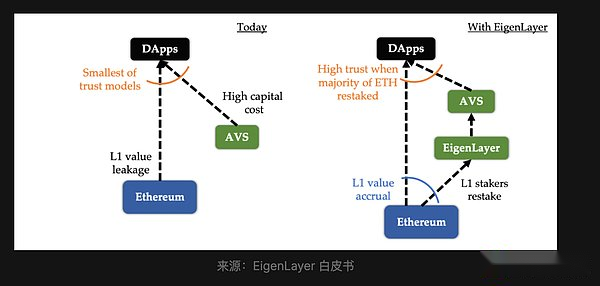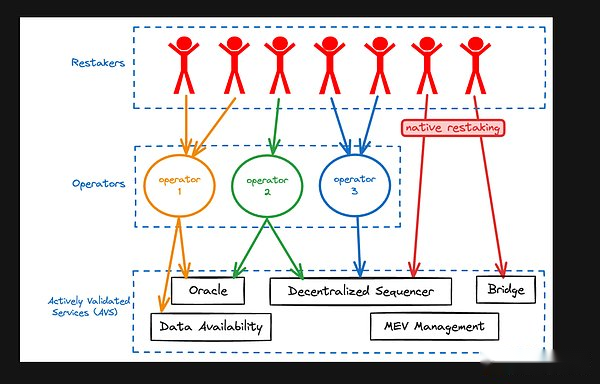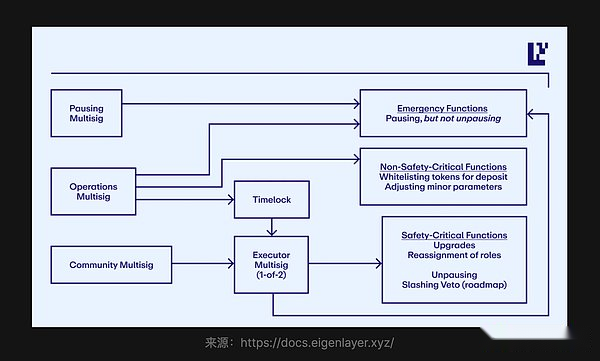
Author: EDA Source: EDATWEETS.ETH Translation: Shan Ouba, Bitchain Vision
There is no doubt that RESTAKING is a key issue in Ethereum in 2024.This term was introduced by Eigenlayer, which quickly became a hot topic in Ethereum World.
A few months ago, I wrote articles about Eigenlayer.Since then, many things have happened, and people’s interest has grown in index level.Therefore, I will return in another article to explore the following content:
-
Eigenlayer’s comprehensive overview: what is it and why you should pay attention to it
-
Current status: What are the new developments currently
-
Risk: What should we pay attention to.
Part 1 -EIGENLAYER: Comprehensive Overview
Eigenlayer is a re -pledge agreement that has received widespread attention for its novelty and innovative methods in the Ethereum field.
Let us first solve the problem that Eigenlayer wants to solve.
Eigenlayer: Simplified network guidance
The equity certificate (POS) network usually requires operators to operate nodes and inspire their efforts through token support.Starting such a network involves many complexity.The key is to design effective tokens, ensure fair distribution, obtain market acceptance, and supervision.These factors have limited the innovation at the infrastructure level.
This is exactly the land of Eigenlayer -solve the challenges related to infrastructure -level innovation.
Its core concept is the basis for using Ethereum’s economic trust as an infrastructure component for advanced projects.To this end, Eigenlayer redefined the guidance process of the POS network.
>
How does EIGENLAYer work?
EIGENLAYER allows developers to use Ethereum’s existing economic security infrastructure, including authentication sets and capital.This process uses the security that Ethereum has established, simplifying the creation of new networks and services.
>
The core is the concept of “re -pledge”.By re -pledge, Eigenlayer can use ETH and verifications pledged ETH and verifications for other services and networks.
Why is this important?
-
Simplifying the development of the network and services: Eigenlayer allows the method of pledged ETH to simplify the process of establishing a new network.It provides real -time economic security and operational support for these networks, and does not require developers to guide these elements from scratch.This not only accelerates the development of the network, but also reduces the entry threshold, and has paved the way for a wider range of networks and services.
-
New pledge opportunities: This model provides new ways to use ETH pledges, which may bring additional rewards.
-
Verifications use: This model provides new opportunities to use existing resources.By participating in multiple networks, they can maximize their utilization and expand their profitable potential.
Detailed overview: role, mechanism and influence
The working principle of the system is described in detail below:
Ethereum pledge
At present, Ethereum network is guaranteed by verifications, and verificationrs use ETH as a capital -based commitment to comply with Ethereum rules.The verification device is responsible for storing data, processing transactions, and adding a new block to the blockchain by running the verification device software.If they do not follow the rules, they will have the risk of losing these ETH.To be a verification person, at least 32 ETH is needed.However, for those who cannot reach this threshold, they can choose to contribute a small amount of ETH by participating in the pledge pool, and the pool is like a group fund managed by others.
Eigenlayer (re -) pledge
Eigenlayer goes further.It expands the role of the verification person and allows them to participate in new networks and systems that need external operators.By doing so, the pledged player can get additional rewards, thereby increasing their participation in the Ethereum ecosystem and providing them with a new way to get rewards.
Before continuing, let’s clarify the participants and their roles.
Participants and roles
-
Pledged: they promise to use ETH to support new networks and services.They have two options:
-
Native re -pledge: pledges can operate independently by undertaking the responsibility of contributing tokens and operations to the Ethereum verification nodes.
-
Entrusted to operators (also known as liquidity re -pledges): The pledges can entrust their ETH to operators, focusing on financial support, while operators handle technical requirements.
-
Operator: These participants manage and run software on Eigenlayer.They play a vital role in maintaining network integrity and will be punished for any improper behavior.
-
Services: These are the networks and services operated by operators -they are called active verification services (AVS) -the next section will introduce this in detail.
-
Service Consumers: These are end users or applications of services provided by the services provided by Eigenlayer.
-
Certain node software requirements
-
Define the condition of reduction (that is, punishment for malicious behaviors).
-
EiGenlayer launched its platform in multiple stages. First, it was pledged on the main network, and then the operator was introduced. Finally, AVS was launched.
-
In June 2023, they launched the re -pledge function on the Ethereum main network.As of writing this article, 648,964.0315 ETH has been pledged(More than 1 billion US dollars!), You can pay attention to it on the dashboard to show the segment of the token.
-
This stage starts with a protected method and test protocol at various stages.Now, Eigenlayer allows you to mortgage liquidity through multiple LST and this machine.
-
Each team is actively developing AVS, where EIGENDA of Eigenlayer is a significant example.In addition to teams from Espresso, Witness Chain, Omni, and Lagrange, you can also learn more here.
-
Please note that AVS is usually not consumer applications, but a service required for consumers for applications.For example, prophet, sharing sequence, bridge.-I will not study in depth for this article, but for the future.
-
The attractiveness of obtaining additional income opportunities by re -pledge may increase the demand for pledged ETH, which affects the overall economy of Ethereum network.
-
In the case of high node requirements on the Internet and services, the potential to obtain higher returns by participating in the pledge of EIGENLAYER may make the choice of separate pledge is no longer so attractive -this meansYou can choose to provide better services to return.On the other hand, if different incentive mechanisms are provided, it can make separate pledge more competitive and capital efficiency.
-
Operator centralization
-
Fairness and reward distribution between operators
-
Improper operator behavior and system security risk
-
The complexity and trust of liquidity pledge
-
Smart contract risk
-
One of the main concerns of Eigenlayer is the risk of centralized operators.If there is a high chain requirement for operators, this problem will occur, which may lead to the concentration of resources and professional knowledge in limited operators.This situation may reduce the attractiveness and feasibility of pledged separately on Ethereum.In other words, if the reward participating in the “entrustment repeat” is higher than becoming a separate repetition, it may hinder the pledge alone.
-
A key aspect of considering is the fairness of reward distribution between operators.In Eigenlayer, operators can choose various services, and each service provides different potential rewards.This setting may significantly change the current “fair” reward system in Ethereum, and each node obtains a similar annual interest rate by mortgage ETH.Different rewarding structures may inspire operators to focus on maximizing returns, which is difficult to maintain a balanced and fair environment for all network authenticants.Now, the verifications need to do more work to understand the project and reward structure -one month they can choose to join a certain AVS, and then choose another to keep looking for better things.
-
(Supplementary centralized argument -Due to different rewards, for local reelection, the choice to entrust to the operator rather than run the software by themselves, thereby changing the verification device allocation on the core protocol may be meaningful.)
-
The possibility of improper behavior of operators is a major risk.Given that operators can participate in multiple AVS, what will happen if they reward & gt; punishment.Then the operator can choose to do dishonent and be willing to lose the shares.If the number of operators involved is small, it may gather together to attack (Attack & gt; loss)Essence(In some cases, you can imagine that the shares required to participate in AVS may exceed the 32 ETH of ETH verification, which may limit the number of operators).
-
In addition, if the mechanism of re -balanced mortgage in Eigenlayer fails due to slow adjustment, delay or incorrect parameters, it may make the system face various security risks.To offset this risk, Eigenlayer proposed a “unbinding period” solution.This method introduced forced delays between the pledged request to withdraw its pledge and the time they could actually access the pledge.(This is an article by Eigenlayer, explaining their methods.) The solution proposed by them seems to effectively solve the vulnerability of the premature exit of malicious operators.EIGENLAYER is actively improving this complex mechanism to enhance the security and effectiveness of this potential risk.
-
When stakeholders use external operators and need to choose AVS, the complexity will appear -which AVS wants to support the stakeholders?EIGENLAYER’s solution involves each AVS combination that operators support to use different addresses (for example, operators using 2 AVS can have 3 addresses: AVS 1, AVS 2, and the two -explanations here).Although this allows pledges to retain their control over their pledge, it introduces a layer of complexity in understanding which address represents which address represents which or which services.In addition, like any blockchain that does not require permission, the question of “can I trust the operator” still exists.
-
Eigenlayer or AVS’s errors and problems in smart contracts may bring inadvertently cut potential risks.In order to reduce the risk of smart contracts, Eigenlayer relies on the governance committee to solve problems caused by accidental cutting.The committee can reverse the reduction of errors or malicious code.
I mentioned “Internet and Services”, but what are these categories that belong to in the context of Eigenlayer?
Understand active verification service (AVS)
Active verification service is a service that requires external operators to operate its network.AVS examples include data availability layers, decentralized sorters, net bridges, prophecy machines, etc.
These services are not only passive entities, but also passive.They have specific operating needs.This includes:
>
Slashing: Make sure Eigenlayer’s honesty
In Eigenlayer, the cooperation between stakeholders and operators is very important.When Stakers commissioned their ETH, they clearly trusted the operator to do honesty.
In order to keep everyone honest, Eigenlayer has a mechanism called “cutting”.If the operator does what you should not do, they may be punished.This means that they may lose some input ETH.
AVS Smart Contracts defines punishment conditions and punish the behavior that violates the rules.For example, operators are facing the risk of great punishment due to the dual signature of the side chain or the signing of the bridge.
This mechanism guarantees the integrity and credibility of the system.
Trust Bazaar: The decentralized market of Eigenlayer
In short, EIGENLAYER has created a decentralized trust market through the trust of Ethereum (Capital + Verification Collection) and provided its components to anyone who is interested.Through this mechanism, stakeholders can choose to provide new services to bring them extra benefits.
>
Part 2 -Current Status: Features layer
Current main online online and total lock value
AVS World
>
EIGENDA
EIGENDA is the data availability service built by Eigenlayer, and is the first AVS launched on the Goerli test network.
This is part of the second stage, including the operator’s verification service running EIGENDA to demonstrate how to operate on Eigenlayer.
At present, the release is limited to the test network.EIGENDA is particularly important because it will be the first service on Eigenlayer.
Note about heavy pledge
Although the term “heavy pledge” is used to describe to tokens pledged on ETH on Eigenlayer, it is essentially an unauthorized pledge platform.The original focus was that ETH was a tokens with facial value, but it could be extended to other forms of assets, such as different tokens.This choice is to support the Ethereum ecosystem and ETH’s relatively low volatility.Although the platform does not have to be bound to ETH and tokens with ETH as the face value, the initial strategy is from these starts.
Part 3 -Risk and Re -evaluation of Ethereum incentives
Re -evaluate incentive measures
A few months ago, Vitalik wrote an article to discuss the potential risk and influence that expands the Ethereum consensus mechanism to its original range.The core information here is that although the consensus mechanism of Ethereum is a powerful tool for maintaining decentralization and security blockchain, decision -making that uses it to exceed its expected purpose may bring risks and challenges, thereby destroying the stability of the systemSex and trust.
Similarly, Justin Drake gave a speech during DevConeCT and discussed related issues and potential solutions.I strongly recommend that you watch this content, which has a very visible overview of potential risks and relieving measures (especially if you have a certain background for MEV).
The key question of re -pledge is how the pledge agreement changes the incentives of Ethereum verifications by providing a reward beyond the visibility of the core agreement, and whether this will change the basic value proposition of Ethereum.
For example:
Admitting that cutting -edge technology like this may encounter some initial challenges -so I have a reservation, and it is still very exciting to see such different things.New ideas and possibilities are endless.
Feature layer risk
Here are some notable risks and more background information:
Operator centralization
Fairness and reward distribution between operators
Improper operator behavior and system security risk
The complexity and trust issues of liquidity re -pledge
Smart contract risk
>
Conclusion
There are many studies to do, including improving AVS, putting these systems into practice, and designing protocols with the core value of Ethereum.Although Eigenlayer’s solution is very promising, they must balance between effectiveness and controllable complexity to ensure the reliability of the system.
I try my best to avoid the use of “Ethereum alignment” that has been reduced to the cause, but I still hope that my information can be clearly conveyed.Do your best to avoid those new hype and vague terminology
It is exciting to see Eigenlayer so many new things emerging in Ethereum world.The pledge was one of the main narratives of Ethereum in 2024, and also praised the Eigenlayer team to keep me excited.








